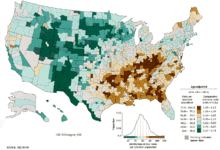Epidemiology[edit]
Worldwide, lung cancer is the most common cancer among men in terms of both incidence and mortality, and among women has the third highest incidence, and is second after breast cancer in mortality. In 2012, there were 1.82 million new cases globally, and 1.56 million deaths due to lung cancer, representing 19.4% of all deaths from cancer.[11] The highest rates are in North America, Europe and East Asia, with over a third of new cases in 2012 in China. Rates in Africa and South Asia are much lower.[133]
The population segment most likely to develop lung cancer is people aged over 50 who have a history of smoking. In contrast to the mortality rate in men, which began declining more than 20 years ago, women's lung cancer mortality rates have been rising over the last decades, and are just recently beginning to stabilize.[134] In the USA, the lifetime risk of developing lung cancer is 8% in men and 6% in women.[1]
For every 3–4 million cigarettes smoked, one lung cancer death occurs.[1][135] The influence of "Big Tobacco" plays a significant role in the smoking culture.[136] Young nonsmokers who see tobacco advertisements are more likely to take up smoking.[137] The role of passive smoking is increasingly being recognized as a risk factor for lung cancer,[25] leading to policy interventions to decrease undesired exposure of nonsmokers to others' tobacco smoke.[138] Emissions from automobiles, factories, and power plants also pose potential risks.[4]
Eastern Europe has the highest lung cancer mortality among men, while northern Europe and the US have the highest mortality among women. In the United States, black men and women have a higher incidence.[139] Lung cancer rates are currently lower in developing countries.[140] With increased smoking in developing countries, the rates are expected to increase in the next few years, notably in China[141] and India.[142]
Lung cancer is the second most common cancer in the UK (around 43,500 people were diagnosed with the disease in 2011), and it is the most common cause of cancer death (around 35,400 people died in 2012).[143]
From the 1960s, the rates of lung adenocarcinoma started to rise relative to other types of lung cancer. This is partly due to the introduction of filter cigarettes. The use of filters removes larger particles from tobacco smoke, thus reducing deposition in larger airways. However, the smoker has to inhale more deeply to receive the same amount of nicotine, increasing particle deposition in small airways where adenocarcinoma tends to arise.[144] The incidence of lung adenocarcinoma continues to rise.[145]



No comments:
Post a Comment